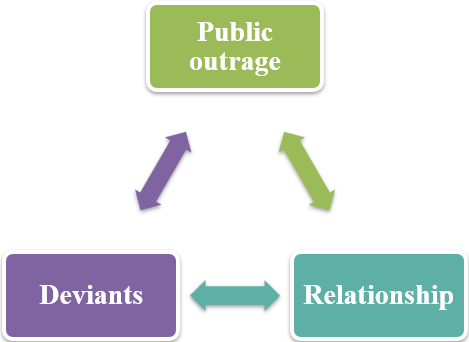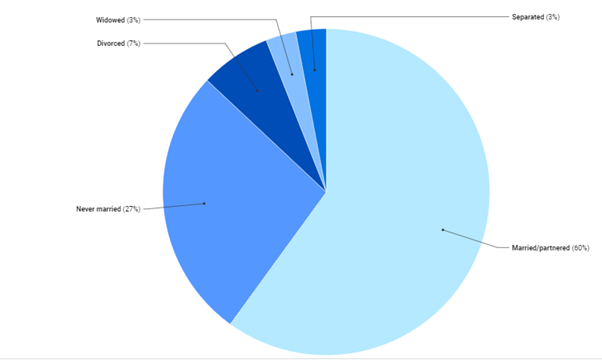Question One: Draw on at least one sociological theory to provide a sociological explanation of current divorce rates.
Divorce and separation from a marriage is a surprising life event that has been experienced by Australians every year. In the last three decades, divorce and separation have grown with their peak and due to this social culture and its effectiveness must be included to manage this crisis. The Government of Australia must focus on this particular aspect and divorce is considered a social feature of Australian society. Additionally, the characteristics and nature of divorced couples change with the increase in the median age for divorce (Mikolai et al., 2019). This is indicating decrease in the proportion of divorces, and the median number of years to separation and divorce involving children under the age of 18 years. This effective trend supporting separation and divorce remains a major problem in social activities in the Australian context.
Figure 1: Structural functionalism theory related to sociology
(Source: Created by author)
Structural functionalism theory is effective for analysing divorce and separation in sociological activities. This theory is mainly based on social science along with relationships, institutions, roles, and norms. Social change is the main theme of this framework and this involves the adaptive response of social activities. Adaptive changes of other parts are maintained by social culture and different activities related to this process. Divorce is a major problem in today’s society and many of the couples in Australia are facing this problem current days (Oel, 2020). Functionalists view divorce from a “negative macroeconomic perspective” and in this regard, a functionalist would have rather attributed the divorce to the failure of social institutions. As a result, individual divorce has been observed in the case of social culture and functionalist development. Several perspectives and opinions are there for providing adequate training and this can be a higher supported social status in a community within a developing country like Australia. Added to this, functionalism is about promoting communication, uniformity, cohesion and these will support historical family and traditional norms to reduce the divorce rates in Australia (Mikolai et al., 2019). Therefore, Structural functionalism theory is effective to identify the effects of divorce and separation within Australia.
Figure 2: Divorce and separation rate in Australia
(Source: Finder, 2021)
Relationships are tricky even at the best of times, and the contribution of couples and their behaviour to each other mainly control relationships and their effectiveness. In recent years, divorce and break up are rapidly increasing for misunderstanding and various difficulties within relationships. Three out of five Australians are partnered or married by 60% and 7% of them are divorced and 275 are never being married (Finder, 2021). According to data from finders,’ it is seen that 56% of women and 65% of men are to be married and partnered. Additionally, 29% of women are not married and 3% of them are separated as well as 4% are widowed. These indicate poor sociological aspects within couples and partners. Victoria is the only state of Australia that has more single adults and more than 29% have never been married (Finder, 2021). Unfortunately, the report is very harmful to Aussies that 69% of them have not even been married and various divorces and separations have been observed.
Question Two: Giddens (1991) describes friendships as ‘pure relationships’. What does he mean by this?
“Pure relationship” is a major principle to manage a suitable lifestyle and friendship is included within it. A true friendship can produce a “pure relationship” and make it more prominent with quality bonding between two individuals. Additionally, a bond between two individuals can be based on trust, love, simply blood relationships, honesty, and marriage. This is based on individuals to determine the link between each other. A bond where two individuals are in a state of being together is friendship, and whereas the bond is greater than this it can be called a relationship (Anthony & McCabe, 2015). The main difference between friendship and relationship is dependency and independence. Added to this, friendship indicates a strong bond between two individuals and they are independent to each other and whereas relationship indicates proper bondage within two and they are committed to each other.
Figure 3: Friendship as “pure relationship”
(Source: Created by author)
A bond of mutual understanding is indicating friendship and a true friendship can transfer into a relationship and that is useful for the individuals’ care, love, sympathy, and many more norms related to mental characteristics and behaviour. The eternal states is considered as friendship and for these different aspects are engaged with the true friendship and these are trust, belief, and many more attributes about human needs (Farci et al., 2017). Close connections between two people are expressed within a relationship and this is cool for those who are couples, partners, and married in their real life. Some physical needs and activities are involved with this case and several activities are performed in an adverse way for understanding each other and managing the exact trust between them relevant to a couple. Apart from that, relationships are sometimes referred to as romantic relationships or martial as well as blood relationships. Every relationship carries the meaning of friendship because a lack of friendship is unable to manage a pure relationship.
The relationship between two individuals involves affection, love, care, and most importantly, devotion to each other. Besides, trust and proper development in personal behaviour are included in strong bondage and that can bring quality friendship and produce a “pure relationship” (Emmeche, 2017). Thus, life revolves around mutual understanding and proper trustworthiness is observed in a relationship, and proper decision-making ability and condition indicate the exact growth of friendship as well as strong bonding.
“Relationship” indicates a lasting and close emotional bond between two individuals that is a common use for a relatively short time. To make it clear and know about its future, some activities must be included within this process. A pure relationship is more limiting than a descriptive concept and has nothing to do with sexual purity. Additionally, it refers to a situation where a social relationship is established through care, trust, and several attributes within it (Anthony & McCabe, 2015). For the majority of the sexually “normal” population, love used to be linked to sexuality through marriage; but now the two are more and more connected through pure relationships. It has no meaning for population groups, and marriage has increasingly developed in the direction of a pure relationship along with different consequences. Thus, it can be said that for building a “pure relationship”, friendship must be included in an adequate manner and social norms.









